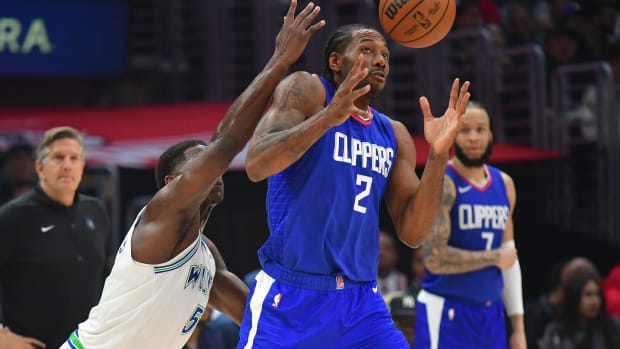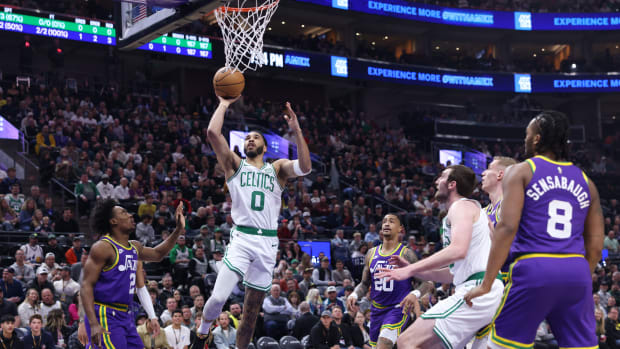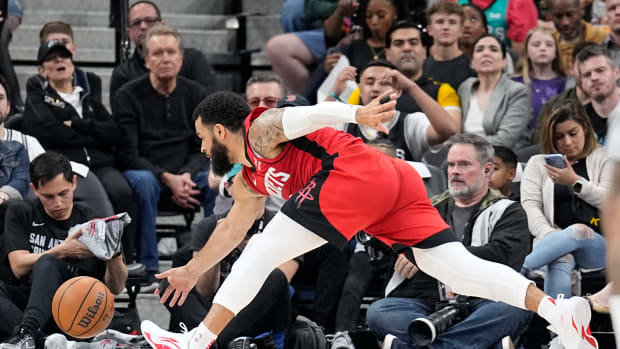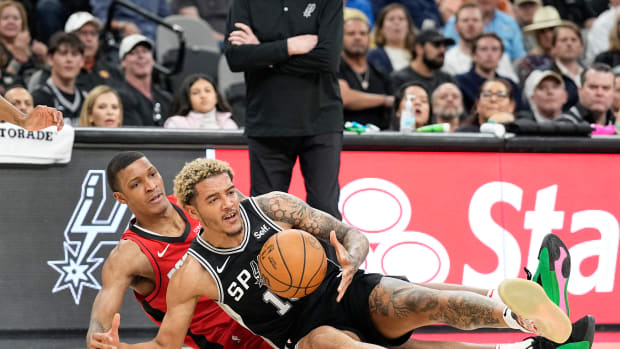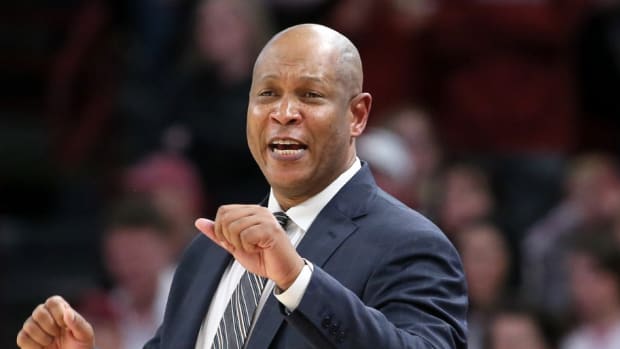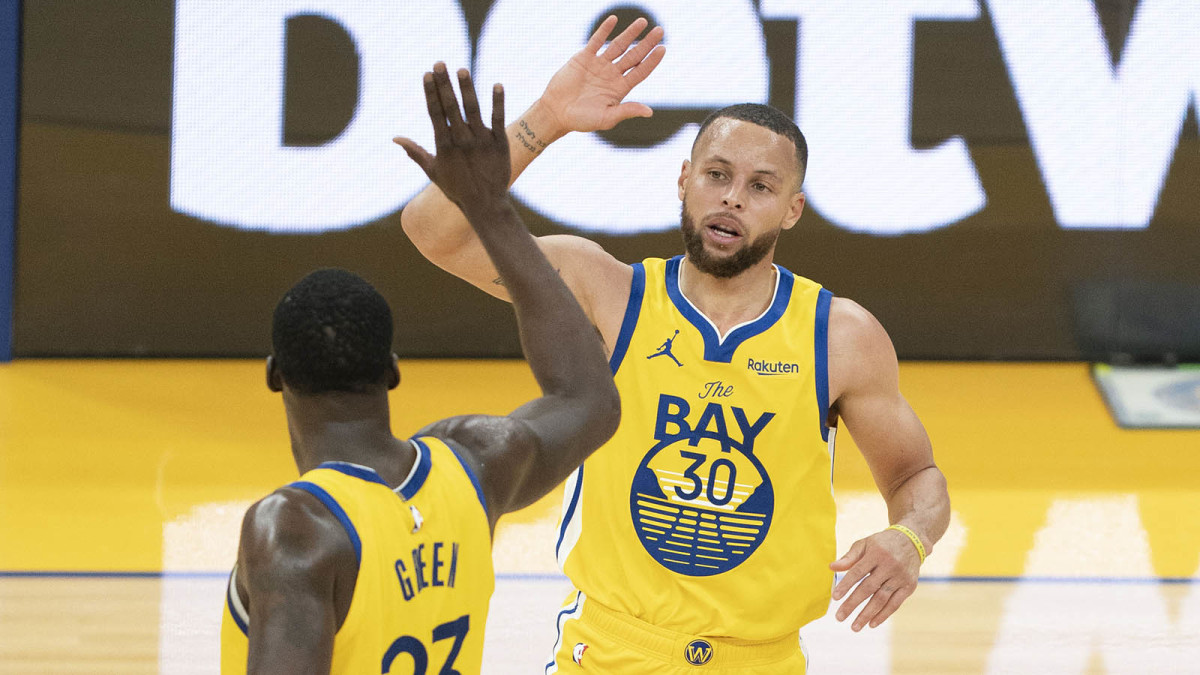
The Tanking Era As We Know It Is Over
Welcome to the Morning Shootaround, where every weekday you’ll get a fresh, topical column from one of SI.com’s NBA writers: Howard Beck on Mondays, Chris Mannix on Tuesdays, Michael Pina on Wednesdays, Chris Herring on Thursdays and Rohan Nadkarni on Fridays.
A gentle advisory to NBA fans: The time has come to put away the cheeky tank GIFs. To cease obsessing over Ping-Pong ball odds in March and April. To stop cheering for losses while repeatedly refreshing tankathon.com.
The Tanking Era as we know it is over.
Take a glance at the standings. Twenty-four of 30 teams are still plausibly competing for something—some jockeying for a top-four seeding and home court advantage; some striving to make the top six, to avoid the new play-in round; and the rest battling to make that play-in tournament, which involves the seventh- through 10th-place teams in each conference.
To repeat: Twenty-four teams are still competing, with about a dozen games left on the schedule. That isn’t just dramatic by recent NBA standards. It’s downright revolutionary.
“Twenty-four is the highest we’ve ever had, in the history of the league, with a month left,” said Evan Wasch, the NBA’s executive vice president of basketball strategy and analytics.
According to Wasch, the biggest gap a team has overcome to make the playoffs, with 15 games left in a season, is four games. (It’s happened twice.) So the league is using that four-game gap as the gauge for “still in contention.” And when the league hit the 15-game mark last week, 24 teams were either firmly in the playoff field or, at worst, within four games of 10th place.
Yes, league officials looked it up. And yes, they’re quite pleased with that stat—and with the rules changes that fostered it.
In 2019 they flattened the draft lottery odds, reducing the incentive to be horrifically bad. This season, they added the play-in tournament, providing a new incentive for middling teams to keep trying, rather than pulling the plug with a month to play.
The results are clear, and encouraging. In the Eastern Conference, six teams are vying for a play-in slot, including three—the Wizards, Bulls and Raptors—who might have given up in past years, given how far they are from eighth place, the old cutoff point. The West also has six teams scrapping to make the play-in, including four—the Warriors, Spurs, Pelicans and Kings—who might have folded if eighth place were still the cutoff point.
As of today, just six teams are clearly out: the Cavaliers, Pistons and Magic in the East; the Rockets, Timberwolves and Thunder in the West. (Are they tanking? We’ll come back to that.) Everyone else has a reason to win. That means fewer teams are shutting down stars with embellished injuries, or benching veterans to “play the kids”—the subtle methods teams have long employed to blunt their winning percentages and enhance their draft standing (aka “tanking”).
“My overarching view is that the rule changes worked,” said Ryan McDonough, the former Suns general manager, and current host of the Audacy NBA Show podcast. “I think it wasn’t one change or the other—it was [both].”
Step 1 was the flatter lottery odds. In the past the team with the worst record had the greatest odds (25%) of winning the top draft pick and was guaranteed a top-four pick. The team with the second-worst record had a 19.9% shot at the No. 1 pick, with the odds decreasing for the third-worst team (15.6%), the fourth-worst team (11.9%) and so on.
Now the teams with the three worst records have identical odds of winning the top pick (14%) and of picking in the top four (52.1%). The team with the fourth-worst record isn’t far behind—with a 12.5% chance of winning the No. 1 pick and 48.1% chance of a top-four pick.
The new odds disincentivized the race-to-the-bottom strategy that took root over the past decade—a trend that deeply disturbed commissioner Adam Silver and spurred the push for lottery reform.
Also dissuading would-be tankers: The actual lottery results the last two years, which underscored the volatility of the new odds. The Pelicans won the 2019 lottery (and Zion Williamson) despite having the seventh-best odds, while the teams with the three worst records all fell (the Knicks, from first to third; the Cavaliers and Suns, to fifth and sixth). The Timberwolves won the 2020 lottery after finishing with the third-worst record, while the Hornets grabbed the No. 2 slot after finishing with the ninth-worst record. The Cavaliers, with the second-worst record, dropped to fifth.
There’s no assured payoff for losing now. But it doesn’t mean teams aren’t still actively working to massage their lottery odds. So who’s tanking?
Most executives point to the Thunder, who shut down a healthy Al Horford in late March in order to, ahem, focus on developing their youth. That push, however, does not include rising star Shai Gilgeous-Alexander, who hasn’t played since March 22, because of a foot ailment (plantar fasciitis). Rival execs believe the Thunder are intentionally taking an ultraconservative approach with Gilgeous-Alexander, holding him out as long as possible (and perhaps the rest of the season), lest he win a few games. Lu Dort, another promising young guard, has been rested frequently this month, though he’s just 22 and healthy.
Two other teams raised eyebrows in recent weeks for resting multiple players at a time: the Raptors and Pistons. Toronto was even fined by the NBA for violating resting rules. And yet the Raptors have won five of their last eight games, including a four-game winning streak, to stay in the play-in hunt. The rebuilding Pistons were bad to start the season, anyway, but they’ve clearly shown no urgency down the stretch, steering into their tailspin.
The Rockets fit the profile of a tanking team, based on some of the decisions they made this season: Trading James Harden for a draft-pick-heavy package from the Nets, instead of choosing a Ben Simmons deal with the 76ers; flipping two useful players, Caris LeVert and Jarrett Allen, for the questionably healthy Victor Oladipo and picks; then flipping Oladipo at the trade deadline for two lesser players.
And Houston has a clear incentive to be bad: Its draft pick can be claimed by Oklahoma City (via a pick swap) unless it lands in the top four.
Minnesota hasn’t made any overt attempts to tank, but it does have incentive to be bad: If its pick falls outside the top three, it goes to the Warriors (as part of last year’s Andrew Wiggins–D’Angelo Russell trade). If they land a top-three pick, the T-Wolves keep it but would send their 2022 pick to the Warriors.
The other bad teams are just bad, not necessarily tanking. Orlando, already sinking fast, blew up its roster at the trade deadline, a decision that was justifiable and frankly overdue. Cleveland hasn’t made any overt roster or lineup decisions to enhance losing.
Also worth noting: Rival executives believe only one team, the Thunder, entered this season with the clear intention of being bad. The rest of the sub-.400 teams were, at some point, trying to win but were undermined by injuries (Magic, Timberwolves), trade demands (Rockets) or just poor roster construction (Cavaliers).
The 2021 draft is considered incredibly talent-rich, especially through the top five. Without the play-in tournament, the Bulls, Raptors, Wizards, Kings, Pelicans and even the Warriors might be shutting down every decent player over the next three weeks in a frenzied bid to collect lottery balls.
So is tanking over? Probably not. There will always be a few teams who tinker around the edges to enhance their lottery odds, even if those odds aren’t as attractive as they once were. But there won’t be as many teams racing to the bottom as in the past. And the multiyear tank job (see the 2013–17 Sixers) appears to be extinct.
The future of the play-in tournament, which was adopted on a one-year trial basis, is a huge key. But given the impact it’s already made, league sources expect easy approval to make it permanent.
“Based on what we’ve seen in terms of team behavior the last few years—the competitiveness on the court and the competitiveness in the standings—we’re pleased with the early results of both the lottery change and the play-in tournament,” said Wasch.
While tanking may persist more subtly on some level, the Tanking Era is almost certainly over.
So go ahead and delete the folder of tank GIFs. And, to the folks at Tankathon.com: Maybe consider a name change.
LUKEWARM TAKE OF THE WEEK: We need a bigger MVP ballot!
I was roundly mocked by my friend Rachel Nichols for suggesting this last year, but I’m not giving up: We need a deeper MVP ballot. Seven slots, instead of the current five. Maybe even 10 slots.
No, it’s not about “participation trophies.” It’s about recognizing the field is always much broader and more diverse than a five-man ballot allows for. Don’t believe me? Let's walk through a quick exercise.
Player X isn’t the MVP, but he’s in the conversation. Player Y absolutely deserves consideration. If Player Z doesn’t get any votes, it’s a travesty!
We hear these statements every spring. Now consider the list of players who fit one of them: Giannis Antetokounmpo. Kawhi Leonard. Stephen Curry. Damian Lillard. Luka Dončić. Chris Paul (or Devin Booker). Rudy Gobert (or Donovan Mitchell). James Harden. Depending on how you view that fifth ballot slot, you could even argue for Jimmy Butler, Zion Williamson, Jayson Tatum and Julius Randle.
Nikola Jokić and Joel Embiid are near locks to finish 1–2 this year. LeBron James—an early favorite before his injury—may still get some down-ballot votes if he returns soon and again dominates down the stretch.
That’s 17 players who are legitimately worthy of consideration—not all of them for the top ballot slots, mind you, but as players who had outstanding (even historic) seasons and a profound impact on their teams.
Every voter has their own approach. So it’s possible these guys will all find their way onto a ballot somewhere. Over the last five awards cycles, 10–13 players have gotten at least one vote in a given year.
But expanding the ballot would give us greater latitude—and provide a more complete snapshot for the history books. There’s no chance that Curry, for example, will win MVP, or even finish in the top three, because the Warriors’ record won’t justify it. Since voters tend to prioritize winning, Curry won’t even make it onto some ballots. Yet Curry is having one of the greatest seasons we’ve seen. Just making him All-NBA first team won’t do it justice.
Expand the ballot to seven slots, and suddenly it’s a lot easier to get Curry, Lillard and Dončić on there. Or Gobert, or Booker, or Williamson.
There’s precedent for a bigger ballot: Major League Baseball has used a 10-slot MVP ballot since 1931. No one, to my knowledge, has ever complained that it dilutes or cheapens the process.
Nothing I’m proposing would change the end result. We’d still have Jokić and Embiid jockeying for the top two spots this year, followed by a crush of Lillards and Lukas and Leonards. But the vast tier of Worthy of Consideration guys would, at least, all get their consideration.
More Morning Shootaround:































